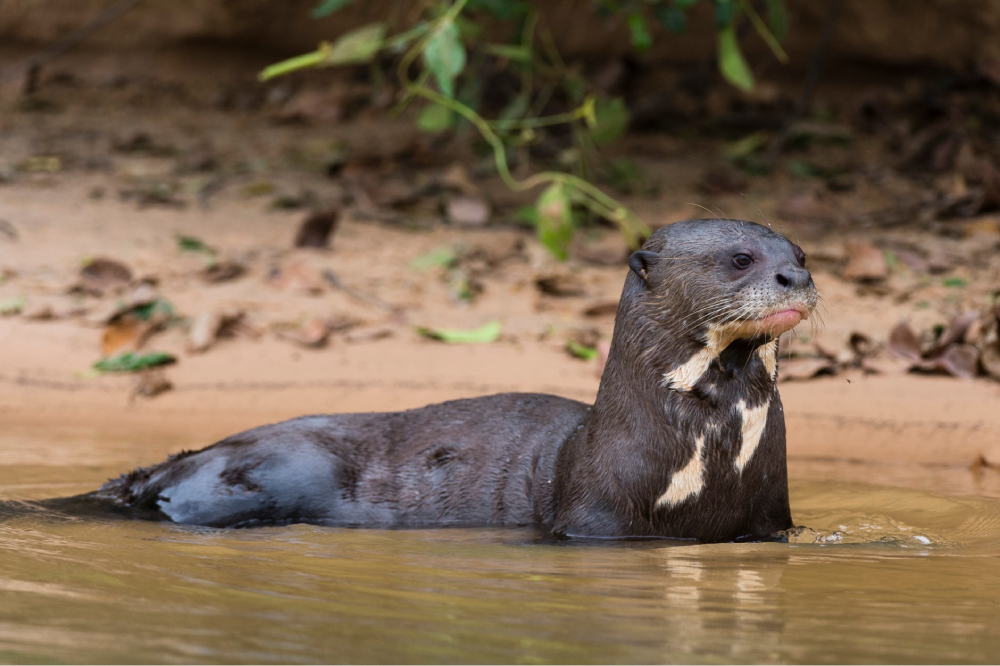The giant otter (Pteronura brasiliensis) is one of the most remarkable and unique creatures inhabiting the rivers and lakes of South America. Known for their impressive size, social behavior, and essential role in the ecosystem, giant otters captivate scientists and nature enthusiasts alike. This article delves into the biology, behavior, habitat, and conservation of these fascinating mammals, shedding light on why they are the Amazon’s playful predators.
Biology and Physical Characteristics
Giant otters are the largest members of the weasel family, Mustelidae. Adult males can reach lengths of up to 1.7 meters (5.6 feet) and weigh between 26 to 34 kilograms (57 to 75 pounds), with females being slightly smaller. Their streamlined bodies are adapted for an aquatic lifestyle, featuring webbed feet, a flat, powerful tail, and dense, water-repellent fur that insulates them in the water. Their fur is a rich, chocolate brown, with distinctive white or cream markings on their throats and chests that are unique to each individual, much like human fingerprints.

Behavior and Social Structure
Giant otters are highly social animals, typically living in family groups called “holts” that consist of monogamous breeding pairs and their offspring. These groups usually number between three to ten individuals, though larger aggregations have been observed. The social structure is complex and cooperative, with older siblings helping to care for younger ones. Communication within these groups is sophisticated, involving a range of vocalizations such as whistles, hums, and screams, each serving different functions from maintaining group cohesion to warding off threats.
Their playfulness is one of their most endearing traits. Giant otters often slide down muddy banks, chasing each other in the water, and playing with objects like sticks and stones. This play behavior is not just for fun; it is crucial for developing hunting skills and strengthening social bonds within the group.
Habitat and Diet
Giant otters are endemic to South America, with a range extending across the Amazon Basin and into the Pantanal, the world’s largest tropical wetland. They prefer slow-moving rivers, streams, and oxbow lakes with abundant fish, their primary food source. These habitats provide the dense vegetation and underwater structures necessary for denning and raising their young.
As apex predators in their ecosystem, giant otters play a critical role in maintaining the balance of aquatic environments. Their diet consists mainly of fish, particularly species like catfish, cichlids, and characins. They are also popular as they eat crustaceans and occasionally small reptiles. An adult giant otter can consume up to 10% of its body weight in fish daily, making them vital in controlling fish populations and preventing overpopulation.
Reproduction and Lifespan
The reproductive cycle of giant otters is closely linked to the seasonal flooding of their habitat. Breeding typically occurs during the dry season when water levels are lower, and there is less risk of floods. After a gestation period of about 65 to 70 days, the female gives birth to a litter of one to six pups in a den dug into the riverbank.
Pups are born blind and helpless, relying entirely on their mother and the group for protection and nourishment. They open their eyes at around three weeks and begin swimming at about nine weeks. Juveniles are weaned by three to four months but remain with their family group to learn vital survival skills. In the wild, giant otters have a lifespan of 10 to 12 years, though they can live longer in captivity.
Threats and Conservation
Despite their formidable presence, giant otters face numerous threats, primarily due to human activities. Habitat destruction is the most significant threat, with deforestation, mining, and hydroelectric dam projects leading to loss of suitable living spaces. Pollution from agricultural runoff and mining operations contaminates the water, affecting both the otters and their prey.
Additionally, poaching for their luxurious fur was a severe problem in the past, driving the species to near extinction in the mid-20th century. While hunting has significantly decreased due to legal protections and increased awareness, illegal poaching still occurs in some regions.
Conservation efforts for giant otters are ongoing and multifaceted. Protected areas such as national parks and reserves play a crucial role in preserving their habitat. Research and monitoring programs help scientists understand their ecology and behavior, providing data necessary for effective conservation strategies. Environmental education and community involvement are also vital, as they promote coexistence and reduce human-wildlife conflict.
International cooperation is essential, given that giant otters inhabit multiple countries in South America. Organizations like the International Union for Conservation of Nature (IUCN) and the World Wildlife Fund (WWF) work with local governments and communities to implement conservation programs and enforce legal protections.
The Importance of Giant Otters
The giant otter is more than just a charismatic species; it is an indicator of the health of its ecosystem. As apex predators, their presence signifies a balanced and thriving environment. Their role in controlling fish populations helps maintain the ecological equilibrium, supporting a diverse array of species that depend on the same habitat.
Moreover, giant otters have significant cultural and economic value. They attract ecotourists, providing income for local communities and promoting conservation through sustainable tourism. Educational programs centered around giant otters raise awareness about the importance of preserving the Amazon and its inhabitants.
Conclusion
The giant otter is a testament to the incredible biodiversity of the Amazon and the intricate web of life that sustains it. These playful predators, with their remarkable social structures and ecological importance, symbolize the need to protect and preserve the natural world. Conservation efforts must continue to ensure that future generations can witness the grace and power of the giant otter in its wild habitat. By safeguarding giant otters, we are also protecting the countless other species that share their environment and the health of the planet as a whole.









